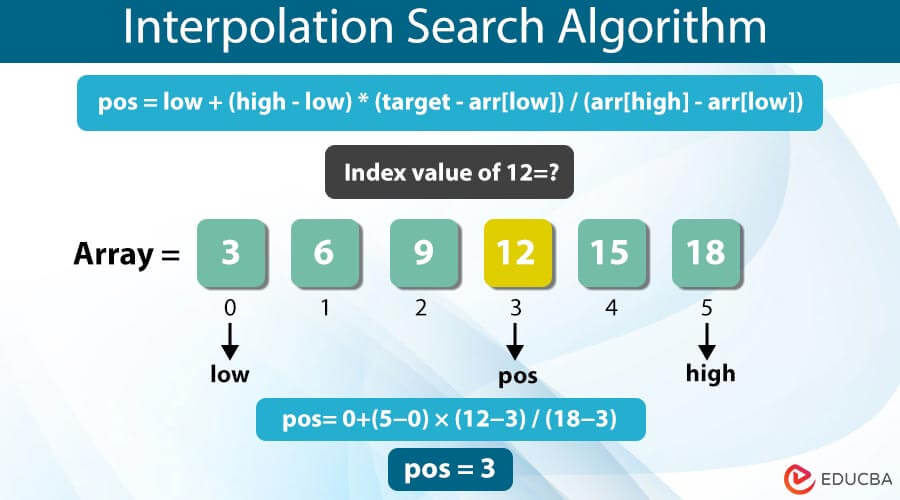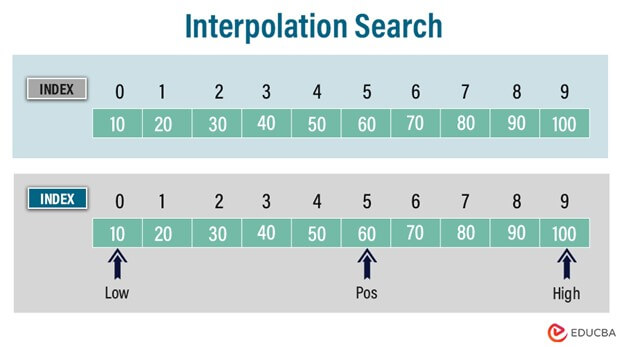Introduction to Interpolation Search Algorithm
Interpolation search, a robust searching algorithm, presents a significant advancement over the conventional binary search approach, particularly when confronted with uniformly distributed data. Unlike binary search, which rigidly divides the search space in half, interpolation search employs value-based estimates and endpoints of the search range to gauge the probable position of the target value. This adaptability proves exceptionally beneficial when navigating data sets with non-uniform distributions or non-linear sorting. Leveraging interpolation formulae, this method intelligently predicts the target’s location within the array, often surpassing binary search performance, primarily when the distribution of values is known or estimable. Its efficacy shines in scenarios featuring large, uniformly distributed data sets, common in the scientific and engineering realms. The algorithm’s proficiency lies in its aptitude for making informed estimations about the target’s whereabouts, diminishing the number of comparisons required to pinpoint the desired element.
Table of Contents
Understanding the Concept of Interpolation Search
It revolves around estimating the probable location of a target value within a sorted array, utilizing its value and the endpoints of the search range. Unlike binary search, which uniformly divides the search space, interpolation search dynamically adapts its approach based on the data distribution, making it particularly effective for uniformly distributed or non-linear datasets.
Let’s consider an array with evenly spaced values:
Suppose we’re searching for the value 60. Instead of blindly splitting the array in half like binary search, interpolation search narrows the search range based on the target value’s estimated position. It’s akin to using a magnifying glass to zoom in on a specific point of interest.
Let’s visualize the process step by step:
- Initial Range:
- Low Range [Lo]: 0
- Low Range Array A[Lo]: 10
- High Range [Hi]: 9
- High Range Array A[Hi]: 100
- Target [X]: 60
- Estimated Target Position:
- We will estimate the target’s position using the formula:
- For target value 60:
- Update Range:
We’ve estimated the target’s position to be at index 5.
New Range: [60, 70, 80, 90, 100]
- Repeat:
Now, we continue the search within the narrowed range until its presence or absence is determined.
Interpolation Search Algorithm Explanation
The interpolation search algorithm is a search technique that improves upon the binary search method by dynamically estimating the probable position of the target value within a sorted array. Unlike binary search, which always divides the search space in half, interpolation search adapts its search strategy based on the values at the ends of the search range and the value it searches for.
Algorithm Pseudocode
Code:
function InterpolationSearch(array, target):
low = 0
high = length(array) - 1
while low <= high and target >= array[low] and target <= array[high]:
# Estimate the position of the target
pos = low + ((target - array[low]) * (high - low)) / (array[high] - array[low])
if array[pos] == target:
return pos # Target found at position pos
elif array[pos] < target:
low = pos + 1 # Search in the right half
else:
high = pos - 1 # Search in the left half
return -1 # Target not foundExplanation:
- Initialize variables low and high to represent the search range boundaries.
- Use a while loop to iterate until finding the target or invalidating the search range.
- Estimate the position of the target within the array using the interpolation formula.
- Compare the target value with the element at the estimated position.
- Return its position upon finding the target.
- If the target is greater than the element at the estimated position, update the low index to continue the search in the right half.
- If the target is smaller than the element at the estimated position, update the high index to continue the search in the left half.
- If it doesn’t find the target within the valid search range, return -1 to signify that it is absent from the array.
Time Complexity
In cases of uniformly distributed elements, interpolation search demonstrates an average time complexity of O(log log n). It signifies that, on average, the algorithm efficiently narrows down the search space logarithmically, offering rapid retrieval of target values. However, in scenarios where the distribution of elements deviates from uniformity, the algorithm’s efficiency may diminish. In such instances, the worst-case time complexity of interpolation search can degrade to O(n), indicating that the search process may linearly scale with the size of the dataset. This variance in time complexity highlights the algorithm’s sensitivity to the distribution patterns within the dataset, emphasizing the importance of considering the data characteristics when selecting an appropriate search algorithm.
Practical Examples
Example 1:
Code:
def interpolation_search(array, target):
low = 0
high = len(array) - 1
while low <= high and target >= array[low] and target <= array[high]:
# Estimate the position of the target
pos = low + ((target - array[low]) * (high - low)) // (array[high] - array[low])
if array[pos] == target:
return pos # Target found at position pos
elif array[pos] < target:
low = pos + 1 # Search in the right half
else:
high = pos - 1 # Search in the left half
return -1 # Target not found
# Example usage:
array = [10, 20, 30, 40, 50, 60, 70, 80, 90, 100]
target = 60
result = interpolation_search(array, target)
if result != -1:
print(f"Target {target} found at position {result}.")
else:
print(f"Target {target} not found in the array.")Output:
Time Complexity:
O(log(log n)) for the average case and O(n) for the worst case
Example 2:
Code:
def interpolation_search(array, target):
low = 0
high = len(array) - 1
while low <= high and target >= array[low] and target <= array[high]:
# Estimate the position of the target
pos = low + ((target - array[low]) * (high - low)) // (array[high] - array[low])
if array[pos] == target:
return pos # Target found at position pos
elif array[pos] < target:
low = pos + 1 # Search in the right half
else:
high = pos - 1 # Search in the left half
return -1 # Target not found
# Example usage:
array = [1, 2, 3, 4, 5, 100, 200, 300, 400, 500]
target = 100
result = interpolation_search(array, target)
if result != -1:
print(f"Target {target} found at position {result}.")
else:
print(f"Target {target} not found in the array.")Output:
Time Complexity:
O(log2(log2 n)) for the average case and O(n) for the worst case.
Pros and Cons
Pros
- Effective Performance with Uniform Data Distribution: It demonstrates remarkable efficiency when dealing with uniformly distributed datasets. In such instances, the algorithm narrows the search space logarithmically, retrieving target values more swiftly than a binary search.
- Adaptive Search Approach: Unlike binary search, which rigidly halves the search space, interpolation search dynamically adjusts its strategy based on the values at the search range’s boundaries and the target value. This adaptive nature empowers the algorithm to make more insightful decisions regarding the next search steps, potentially diminishing the required number of comparisons.
- Applicability to Large Data Volumes: It is advantageous for exploring extensive datasets, particularly when the distribution of elements is identifiable or estimable. Its proficiency in efficiently traversing sorted arrays renders it a practical choice for applications handling substantial data loads.
Cons
- The sensitivity to data distribution: While the algorithm excels in evenly distributed data, its effectiveness can diminish considerably when data distribution varies. The algorithm’s performance may suffer when elements are unevenly spaced, potentially reverting to linear search behavior in unfavorable conditions.
- The complexity of implementation: Successfully implementing interpolation search demands a solid grasp of the interpolation formulas employed to estimate the target’s position within the array. This implementation complexity might dissuade developers from opting for interpolation search, particularly for smaller datasets or instances where data distribution is uncertain, favoring simpler alternatives.
- The limited scope of application: It shines brightest when navigating sorted arrays. Nevertheless, its suitability may be compromised when applied to other data structures or unsorted datasets. Developers must carefully assess the characteristics of their data and their application requirements to determine whether interpolation search is the most appropriate choice.
Applications and Use Cases
- Database Systems: Within database systems, interpolation search is a go-to method for swiftly searching through sorted indexes or tables. This system is particularly beneficial in large databases where speedy retrieval of records based on sorted keys is paramount.
- Scientific Computing: It plays a crucial role in scientific computing, aiding in pinpointing specific data points within sorted arrays representing experimental results or numerical simulations. This computing is invaluable across physics, engineering, and computational biology disciplines.
- Geographic Information Systems (GIS): GIS applications frequently entail searching and retrieving spatial data from sorted arrays or databases. Here, interpolation search streamlines the querying process of geographic datasets, facilitating swift access to pertinent spatial information.
- Financial Systems: In financial systems, interpolation search is instrumental for searching and retrieving financial data stored in sorted arrays or databases. It serves essential functions like historical stock price lookup, market analysis, and algorithmic trading.
- Compiler Design: It finds utility in compilers and interpreters for efficiently navigating symbol tables or symbol tables represented as sorted arrays. This design expedites the resolution of identifiers and symbols during the compilation or interpretation.
- Text Processing: Text processing applications leverage interpolation search to retrieve data from sorted text corpora or databases. This processing proves invaluable for tasks such as information retrieval, text mining, and NLP (Natural Language Processing).
- Online Retail: Within e-commerce platforms, interpolation search enhances search functionality for products listed in sorted catalogs. It empowers users to find relevant products based on their preferences and search queries.
Conclusion
Interpolation search is a valuable tool for efficiently navigating sorted datasets across various applications. Its adaptive search strategy and efficiency with uniformly distributed data make it a preferred choice in scenarios where quick retrieval of target values is crucial. However, its sensitivity to data distribution and potential for degraded performance in non-uniform datasets underscore the importance of careful consideration when selecting this algorithm. Despite its limitations, interpolation search remains relevant in database systems, scientific computing, GIS, financial systems, compiler design, text processing, and online retail, among other fields. As technology advances and datasets grow more complex, interpolation search remains a versatile and effective solution for efficient data retrieval and information processing tasks.
Frequently Asked Questions (FAQs)
Q1. Can interpolation search be used with non-numeric data?
Answer: While commonly used with numeric data, interpolation search can adapt to non-numeric data types, like strings. However, adjustments may be necessary to the interpolation formula for estimating positions.
Q2. Does interpolation search require sorting the array?
Answer: Interpolation search is most effective when applied to sorted arrays. Pre-sorting the array ensures the algorithm can accurately estimate the target value’s position and conduct efficient searches.
Q3. Are there any variations or optimizations of the interpolation search?
Answer: Yes, several optimizations and variations of interpolation search exist, including techniques like exponential interpolation search and double interpolation search. These adaptations aim to enhance the algorithm’s efficiency, particularly in specific scenarios or with particular data
Recommended Articles
We hope that this EDUCBA information on “Interpolation Search Algorithm” was beneficial to you. You can view EDUCBA’s recommended articles for more information,


